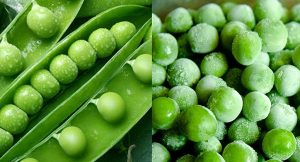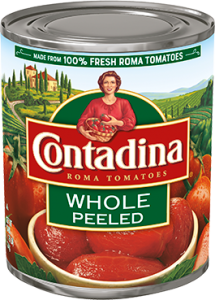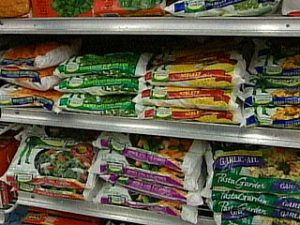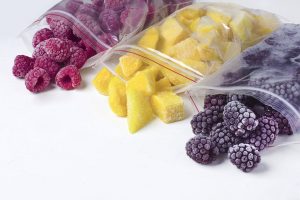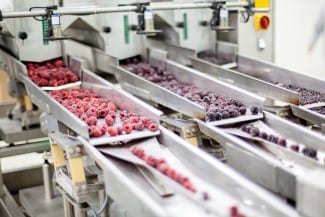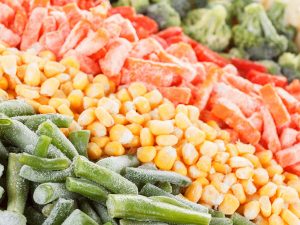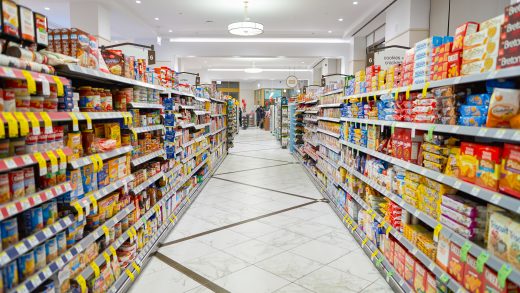Big name chefs are always talking about the need to use the freshest ingredients. That’s great if you live somewhere like Southern California, where produce grows all the year around. For most of us, what we can get fresh depends on the time of year and where we are. The Midwest doesn’t get a lot of fresh seafood, and what there is usually go to restaurants. Everyone else has to contend with “previously frozen.” Not that there’s anything wrong with that. But freezing does change cells of flesh which might affect the taste. Around here, tomatoes in Winter will cost $3 a pound and have no taste because they had to be picked several days ago while still green to make the trip to your store’s Produce aisle without rotting.
Canned produce is good in some cases, often frozen is better, and fresh is just out of the question. We like keeping canned tomatoes and beans around in the pantry so we can make something on the spur of the moment if needed. But many canned foods lose something in the process. For example, anything green. To me, green vegetables like green beans or peas look gray and unappetizing.
Frozen is often the best choice for your kitchen. Frozen produce and meat can stay in the freezer for weeks, maybe months. Produce destined for the processing plant, which is usually nearby, can wait until their peak to be harvested. They are then blanched or steamed before freezing.
Is Frozen Always The Better Choice?
Frozen produce is convenient and generally safe. However, it may not be safe enough to eat without further cooking. It can still harbor bacteria that cause foodborne illness, like Salmonella and Listeria.
In 2016, more than 450 frozen produce from more than 40 brands were recalled because of an outbreak of listeriosis, the disease called by Listeria monocytogenes. Since then, frozen fruits and vegetables have been recalled at least 20 times because of possible contamination with listeria, hepatitis A or norovirus in multiple states. According to the federal Food and Drug Administration data, these could have been contaminated at the farm, during or after harvesting. These were not found because someone got sick, but through routine testing by the food manufacturer. There are plenty of opportunities for an airborne pathogen to contaminate the food even then.
The good news is that the food producers really are doing a good job in keeping the food supply as safe as possible. In recent tests by Consumer Reports magazine, no pathogens that could make someone sick were found in a sample of nearly 400 frozen produce items.
Listeria is the biggest concern since it has more possible sources than e. coli or salmonella. Since 2017, the frozen food industry has taken steps against contamination, including more sampling and more routine cleaning of equipment. And it has worked.
Completely Safe?
Nothing is completely safe, but the chance of contamination for frozen produce is pretty low. Still, some things can slip through, so always cook your frozen veggies.
Many people eat frozen fruit, like when they make a smoothie, for example. But the same risk is there. While the industry is trying hard to prevent contamination, there’s only so much you can do and keep the produce raw. But the track record is pretty good.
Fresh vs. Frozen vs. Canned
The Centers for Disease Control says about 90% of all Americans don’t eat enough fruits and vegetables. Frozen produce can make that easier to reach by saving you time and effort. They are already cleaned and chopped. It’s there when you need it and can stay in the freezer for months.
Fresh produce is already starting to rot before it even reaches the produce aisle. Most fresh fruits and vegetables begin to deteriorate almost immediately after being cut from the plant. There are some exceptions, like bananas, that continue to ripen even after being picked.
One of the biggest problems we have today is food waste. Frozen certainly beats fresh in that department. The U.S.D.A. says the average family of four wastes about $1,500 worth of food each year. Fresh fruit and vegetables make up a large portion of that.
There are advantages to having some canned fruit and vegetables around to keep a well stocked pantry. Canned fruit, as with tomatoes, are often a better choice than fresh when something is out of season. Applesauce is full of fiber and a good thing to have around as a sweetener if you don’t or can’t use sugar.
What About Nutrition?
Fresh fruits and vegetables are packed with nutrients and that doesn’t change when they are frozen. Canned produce is always cooked. Frozen is usually only flash cooked a tiny bit, so it doesn’t lose many nutrients compared to fresh.
The rule should always be: Get the best ingredients you can afford. The nutritional benefits of frozen is just as good as fresh. For canned foods, it depends on what food is inside. Canned tomatoes actually have more nutrients than the fresh version.
Research has generally found that the nutritional differences between fresh and frozen produce are small. And frozen versions were actually better than fresh items that have been stored in a refrigerator for five days.
